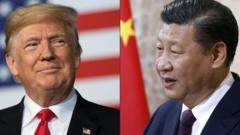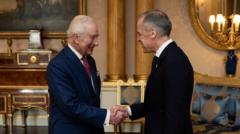As tariffs soar and tensions rise, the US and China face a stalemate, each side hesitant to initiate talks. The world watches to see whether Trump or Xi will make the first move towards de-escalation before an economic downturn ensues.
The US-China Trade Standoff: Will Either Side Compromise?

The US-China Trade Standoff: Will Either Side Compromise?
Amid escalating tariffs, the US and China engage in a delicate dance of potential negotiation, but neither side appears willing to budge.
In a high-stakes battle of wills, both the United States and China grapple with escalating tariffs that threaten to derail their economies. On Friday, a spokesperson from China's ministry of commerce revealed that Beijing is exploring the possibility of tariff negotiations, a development that has garnered significant attention globally. With tariffs reaching as high as 245% on select Chinese exports, the relationship between these two economic giants has become increasingly strained, prompting fears of impending recessions in both countries.
“US officials have expressed a clear willingness to enter discussions,” the spokesperson remarked during a press briefing. However, the tone from China was unwavering, asserting that if negotiations are to occur, the US must demonstrate genuine intent by scaling back unilateral tariffs. This news follows conflicting reports, with a Chinese state media-linked Weibo account attributing the initiation of discussions to the US, a claim that was subsequently dismissed by Beijing.
The ongoing situation has led experts to liken the scenario to a tactical game of chicken between President Trump and President Xi Jinping, as both leaders try to navigate the diplomatic waters without appearing weak. “Nobody wants to be the one to back down first,” stated Ja Ian Chong, a political science professor at the National University of Singapore. “Both Washington and Beijing have an incentive to de-escalate, but neither is willing to show signs of concession.”
Some commentators argue that the current deadlock is emblematic of "constructive ambiguity," where each party's vague statements can be interpreted in multiple ways, leaving open the possibility that both could save face. A post by Yuyuantantian, associated with Chinese state media, highlighted the notion that the US appears more anxious to negotiate, which has led observers to speculate about the underlying motivations of both parties.
A potential solution to this impasse could involve the participation of a neutral third party to facilitate dialogue or a broader interpretation of what it means for one side to reach out for negotiations. This could allow the one that does fold first to frame it not as a defeat, but as a strategic response to the other's overtures.
Crucially, the optics of negotiations are as important as the substance. For Trump, who faces economic challenges and public concern over a recession, it is vital to project a narrative of having compelled China to make concessions. Meanwhile, Xi must balance international relations with the domestic narrative that portrays China as an ascendant power, unyielding to Western pressures.
As the clock ticks, both leaders are under pressure to portray successes to their respective audiences. While negotiations may be in the cards, it remains to be seen whether either leader will take that necessary first step. Political analysts conclude that despite rhetoric around forthcoming talks, both the US and China are still in a waiting game, each side hoping for the other to show signs of desperation first before entering any agreements.




















